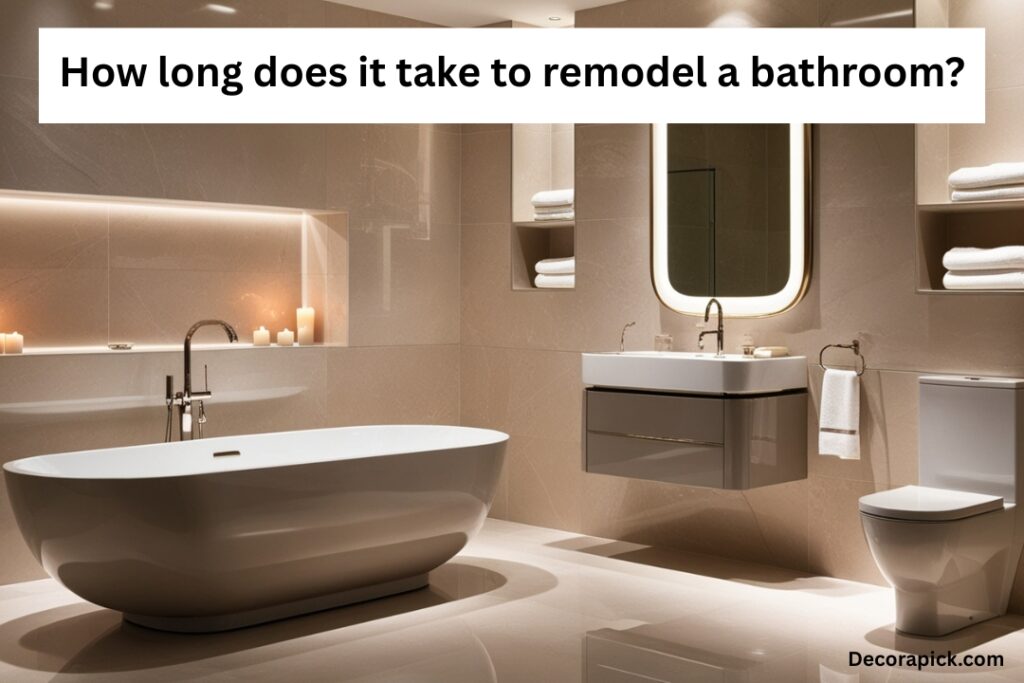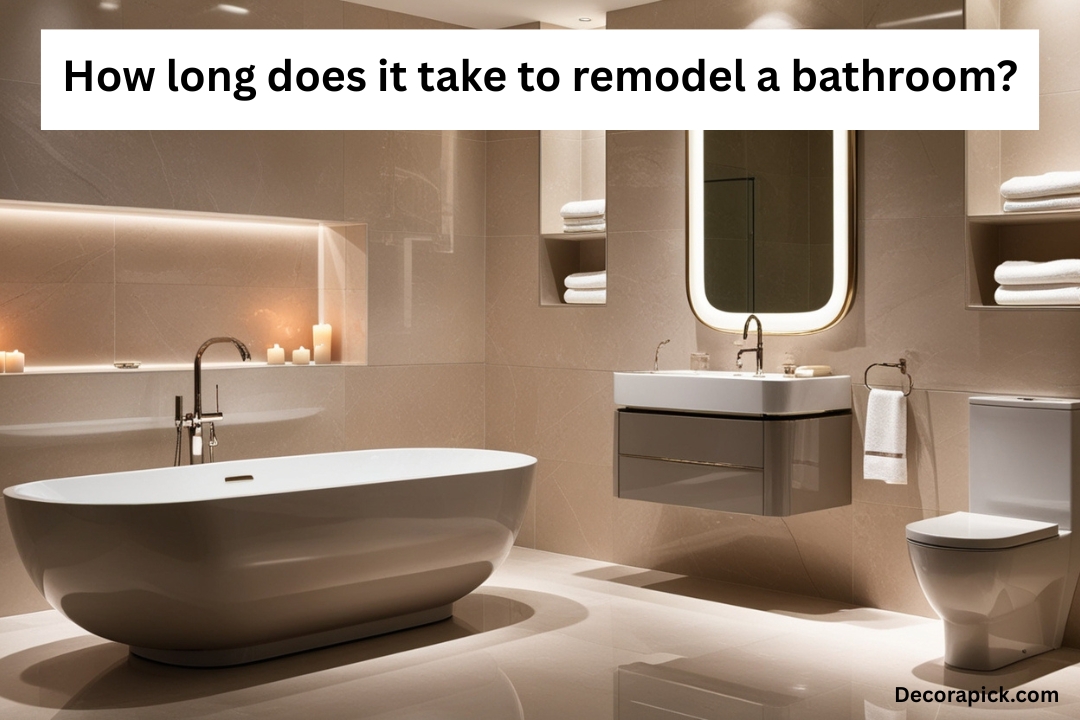Thinking about remodeling your bathroom but unsure how long it will actually take? You’re not alone. For many homeowners, one of the first questions that comes up is: “How long does a bathroom remodel really take?”
A bathroom remodel is more than just a facelift—it’s a chance to upgrade your daily routine, fix lingering issues, and add serious value to your home. Whether you’re refreshing an outdated look, expanding the space, or dealing with wear and tear, this project can be one of the most rewarding home improvements you make.
But timelines can vary widely depending on the bathroom size, renovation scope, material availability, and whether you’re hiring professionals or going the DIY route.
Wouldn’t it be great to go into your remodel with a clear understanding of what to expect? Knowing the average duration, step-by-step phases, and potential setbacks can save you time, stress, and money. With the right planning, your bathroom transformation can be smooth, efficient, and even enjoyable.
In this blog post, we’ll walk you through everything you need to know about bathroom remodeling timelines—from average timeframes and key stages to common delays and smart tips to stay on track. Let’s dive in and take the guesswork out of your renovation journey.
Explore more helpful guides, tips for home improvement in Decora Pick.

Typical time Frames Based on Bathroom Type
Bathroom remodels can range in complexity from simple cosmetic upgrades to full-scale renovations. Here are some rough time estimates:
- Half-Bath/Powder Room: 1.5 to 3 weeks
- Standard Full Bathroom: 3 to 5 weeks
- Large or Master Bathroom: 5 to 8 weeks
- Luxury Spa Bathroom with Custom Features: 8 to 12 weeks or longer
These are average timelines when working with licensed professionals and assuming no major setbacks. DIY remodels may take significantly longer, depending on your experience and available time.
The Phases of a Bathroom Remodel
Understanding the various phases involved can help you visualize the full scope of the project. Each phase contributes to the overall timeline:
Planning and Design
This phase includes:
- Determining your goals for the remodel
- Establishing a realistic budget
- Hiring contractors or designers
- Finalizing layout and design
- Choosing materials, fixtures, colours, and finishes
The more prepared you are in this stage, the smoother the rest of the project will go.
Permits and Ordering Materials
Many remodels require permits, especially if plumbing, electrical, or structural work is involved. At the same time, you will order materials such as tile, vanities, bathtubs, sinks, and lighting fixtures.
Custom or back-ordered items can take weeks, so ordering everything before demolition is key to staying on schedule.
Demolition
Once everything is planned and in place, demolition begins. This includes removing:
- Old flooring and wall tile
- Vanity, sink, toilet, tub, or shower
- Outdated lighting and plumbing fixtures
- Proper disposal and cleanup are also part of this phase.
Rough-In Work
This phase involves laying the groundwork:
- Plumbing lines are relocated or updated
- Electrical wiring and lighting placements are installed
- HVAC or ventilation systems are addressed if necessary
- Once rough-ins are complete, inspections may be required.
Inspections
Building inspectors will check the rough plumbing, wiring, and structural changes to ensure they meet the code. The inspection must be passed to proceed. Failing may require corrections that can delay the next steps.
Drywall, Waterproofing, and Subflooring
- Drywall is installed or repaired around new layouts
- Cement backer boards are laid in wet areas
- Waterproof membranes are applied
This is crucial for longevity, especially in high-moisture areas like showers and bathtubs.
Tiling and Flooring
Tile installation is time-consuming and meticulous. Grout, levelling, and sealing must also be adequately cured.
- Floor tiles are laid and sealed
- Shower and wall tiles are installed
- Any decorative tiling or backsplashes are completed
Fixture Installation
After flooring and tiling are finished, fixtures are installed:
- Bathtub or shower units
- Toilet
- Vanity and sink
- Faucets, drains, and plumbing hookups
- Electrical fixtures and lighting
Painting and Trim
The walls are primed and painted. During this phase, baseboards, crown molding, and any decorative trim are added. Touch-ups are made to correct any marks or scratches from construction.
Final Touches and Cleanup
- Caulking around fixtures
- Hanging mirrors and accessories
- Installing towel bars, shelves, and organizers
- Final deep clean to remove construction dust
The bathroom is now ready for use!
Common Delays in Bathroom Remodels
Bathroom renovations rarely go 100% according to plan. Here are some common delays to anticipate:
- Backordered or unavailable materials
- Permit approval slowdowns
- Scheduling conflicts with subcontractors
- Hidden issues like mould, rot, or outdated wiring
- Unexpected structural damage or plumbing reroutes
- To avoid frustration, always build a buffer of at least 1 week into your schedule.
DIY vs. Professional Remodel Timelines
DIY Remodels can save money but usually take longer. If you do the work on evenings and weekends, even a basic remodel could take 6–12 weeks or more.
Professional Remodels are more efficient, mainly if managed by a general contractor. A good team can finish on time and catch issues before they become costly problems.
Tips to Stay on Schedule
- Finalize your design and materials before you begin
- Hire reputable, licensed contractors
- Create a project timeline and communicate clearly with your team
- Expect surprises—and do not panic when they happen
- Be available to make quick decisions if changes are needed
Conclusion: Patience Pays Off in a Bathroom Remodel
Remodeling a bathroom is not a weekend job. It requires time, patience, planning, and a bit of flexibility. On average, a professionally managed remodel takes 3 to 8 weeks, depending on complexity. DIY projects may take longer, but they can be just as successful with the proper preparation.
Understanding each phase of the remodel and preparing for the inevitable hiccups along the way can make the process smoother—and even enjoyable. The result? A beautiful, functional bathroom that you will enjoy for years to come.
Frequently Asked Questions
Can I use my bathroom during the remodel?
Generally, no. Once demolition begins, the bathroom is out of commission. Plan for alternative bathroom use.
How much does it cost to remodel a bathroom?
The national average ranges from $8,000 to $20,000 depending on size, location, and scope.
What is the best time of year to remodel a bathroom?
Spring and summer are popular due to better weather and easier drying times, but remodels can be done year-round.
Is it worth remodeling a bathroom before selling a house?
Yes. Bathroom upgrades offer the best returns on investment and can help your home sell faster.
Do I need a permit for a bathroom remodel?
Usually yes, especially if plumbing, electrical, or layout changes are involved. Check with your local building department.

